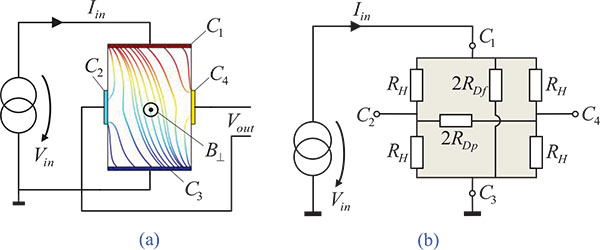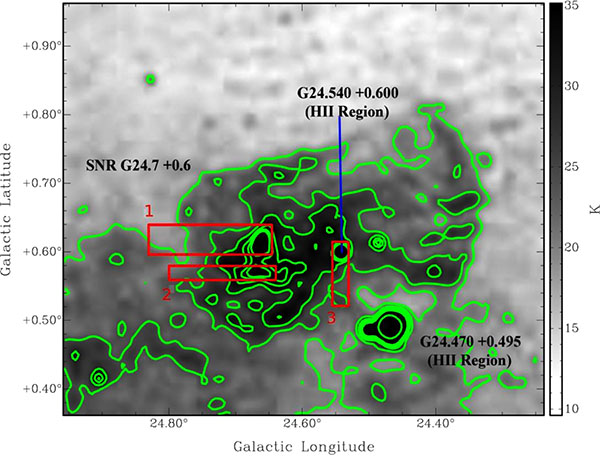RESEARCH ARTICLE
Emergence and Violation of Geometrical Scaling in pp Collisions§
Michal Praszalowicz*
Article Information
Identifiers and Pagination:
Year: 2014Volume: 1
Issue: Suppl 1: M5
First Page: 43
Last Page: 47
Publisher Id: PHY-1-43
DOI: 10.2174/1874843001401010043
Article History:
Received Date: 25/11/2013Revision Received Date: 29/1/2014
Acceptance Date: 30/1/2014
Electronic publication date: 31/12/2014
Collection year: 2014
open-access license: This is an open access article licensed under the terms of the Creative Commons Attribution Non-Commercial License (http://creativecommons.org/licenses/by-nc/3.0/) which permits unrestricted, non-commercial use, distribution and reproduction in any medium, provided the work is properly cited.
Abstract
We argue that geometrical scaling (GS) proposed originally in the context of Deep Inelastic Scattering (DIS) at HERA works also in pp collisions at the LHC energies and in NA61/SHINE experiment. We show that in DIS GS is working up to relatively large Bjorken x ~ 0.1 . As a consequence negative pion multiplicity pT distributions at NA61/SHINE energies exhibit GS in mid rapidity region. For y ≠ 0 clear sign of scaling violations can be seen when one of the colliding partons has Bjorken x ≥ 0.1 . Finally, we argue that in the case of identified particles GS scaling is still present but the scaling variable is a function of transverse mass rather than pT.
PACS number(s): 13.85.Ni,12.38.Lg.
1. INTRODUCTION
This talk based on refs. [1-6] (where also an extensive list of references can be found) follows closely an earlier report of ref. [7]. We shall discuss the scaling law, called geometrical scaling (GS), which has been introduced in the context of DIS [8]. It has been also shown that GS is exhibited by the pT spectra at the LHC [1, 3] and that an onset of GS can be seen in heavy ion collisions at RHIC energies [3]. At low Bjorken x < xmax gluonic cloud in the proton is characterized by an intermediate energy scale Qs (x), called saturation scale [9, 10]. Qs (x) is defined as the border line between dense and dilute; gluonic systems (for review see e.g. refs. [11, 12]). In the present paper we study the consequences of the very existence of Qs (x); the details of saturation phenomenon are here not of primary importance.
Here we shall focus of four different pieces of data which exhibit both emergence and violation of geometrical scaling. In Sect. 2 we briefly describe the method used to assess the existence of GS. Secondly, in Sect. 3 we describe our recent analysis [4] of combined HERA data [13] where it has been shown that GS in DIS works surprisingly well up to relatively large xmax~0.1 (see also [14]). Next, in Sect. 4, on the example of the CMS pT spectra in central rapidity [15], we show that GS is also present in hadronic collisions. For particles produced at non-zero rapidities, one (larger) Bjorken x=x1 may be outside of the domain of GS, i.e.x1>xmax, and violation of GS should appear. In Sect. 5 we present analysis of the pp data from NA61/SHINE experiment at CERN [16] and show that GS is indeed violated once rapidity is increased. Finally in Sect. 6 we analyze identified particles spectra where the particle mass provides another energy scale which may lead to the violation of GS, or at least to some sort of its modification [6]. We conclude in Sect. 7.
2. ANALYZING DATA WITH METHOD OF RATIOS
Geometrical scaling hypothesis means that some observable σ depending in principle on two independent kinematical variables, like x and Q2, depends in fact only on a given combination of them, denoted in the following as τ:
1
Here function F in Eq. (1) is a dimensionless universal function of scaling variable τ:
2
and
3
is the saturation scale. Here Q0 and x0 are free parameters which, however, are not of importance in the present analysis, and exponent λ is a dynamical quantity of the order of λ ~ 0.3. Throughout this paper we shall test the hypothesis whether different pieces of data can be described by formula (1) with constantλ, and what is the kinematical range where GS is working satisfactorily.
As a consequence of Eq. (1) observables σ(xi,Q2) for different xi's should fall on a universal curve, if evaluated in terms of scaling variable τ. This means that ratios
4
should be equal to unity independently of τ. Here for some xref we pick up all xi < xref which have at least two overlapping points in Q2.
For λ≠0 points of the same Q2 but different x's correspond in general to different τ's. Therefore one has to interpolate σ(xref,τ(xref,Q2;λ)) to Q2k,ref such that τ(xref,Q2k,ref;λ)=τk. This procedure is described in detail in ref. [4].
By adjusting λ one can make Rxi,xref(λ;τk)→ 1 for all τk in a given interval. In order to find an optimal value λmin which minimizes deviations of ratios (4) from unity we form the chi-square measure
5
where the sum over k extends over all points of given xi that have overlap with xref, and Nxi,xref is a number of such points.
3. GEOMETRICAL SCALING IN DIS AT HERA
In the case of DIS the relevant scaling observable is γ* p cross section and variable x is simply Bjorken x. In Fig. (1) we present 3-d plot of λmin(x,xref) which has been found by minimizing (5).
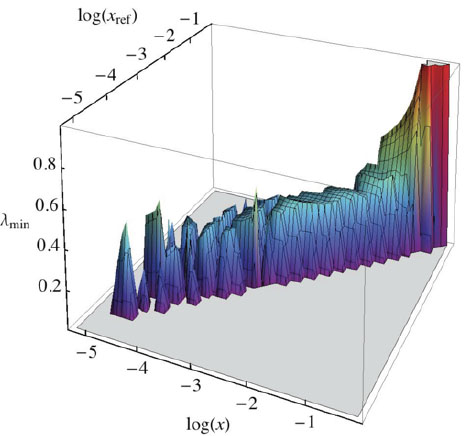 |
Fig.(1). Three dimensional plot of λmin(x, xref) obtained by minimization of Eq. (5). |
Qualitatively, GS is given by the independence of λmin on Bjorken x and by the requirement that the respective value of χ2x,xref(λmin) is small (for more detailed discussion see ref. [4]). One can see from Fig. (1) that the stability corner of λmin extends up to xref~0.1, which is well above the original expectations. In ref. [4] we have shown that:
6
4. GEOMETRICAL SCALING OF CENTRAL RAPIDITY pT SPECTRA AT THE LHC
In hadronic collisions at c.m. energy
7
For central rapidities x=x1 ~ x2 In this case charged particles multiplicity spectra exhibit GS [1]
8
where F is a universal dimensionless function of the scaling variable (2). Therefore the method of ratios can be applied to the multiplicity distributions at different energies (Wi taking over the role of xi in Eq. (4))1. For Wref we take the highest LHC energy of 7 TeV. Hence one can form two ratios RWref,Wi with W1 = 2.36 and W2 = 0.9 TeV. These ratios are plotted in Fig. (2) for the CMS single non-diffractive spectra for λ = 0 and for λ = 0.27, which minimizes (5) in this case. We see that original ratios plotted in terms of pT range from 1.5 to 7, whereas plotted in terms of
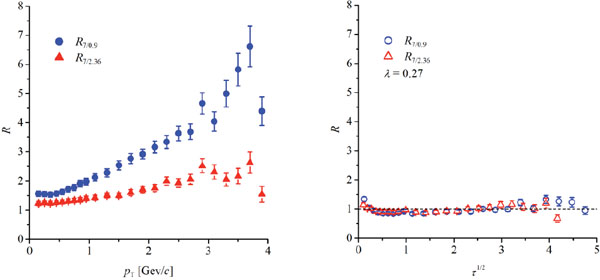 |
Fig.(2).
|
5. VIOLATION OF GEOMETRICAL SCALING IN FORWARD RAPIDITY REGION
For y > 0 two Bjorken x's can be quite different: x1 > x2. Therefore by increasing y one can eventually reach x1 > xmax and GS violation should be seen. For that purpose we shall use pp data from NA61/SHINE experiment at CERN [16] at different rapidities y = 0.1-3.5 and at five scattering energies W1,...,5 = 17.28, 12.36, 8.77, 7.75 , and 6.28 GeV.
In Fig. (3) we plot ratios R1i = RW1,Wi (4) for π- spectra in central rapidity for λ = 0 and 0.27. For y = 0.1 the GS region extends down to the smallest energy because xmax is as large as 0.08. However, the quality of GS is the worst for the lowest energy W5. By increasing y some points fall outside the GS window because x1 ≥ xmax, and finally for y ≥ 1.7 no GS is present in NA61/SHINE data. This is illustrated nicely in Fig. (4).
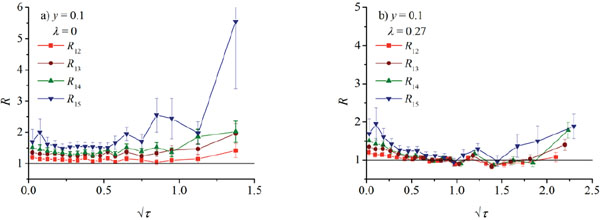 |
Fig.(3).
|
 |
Fig.(4).
|
6. GEOMETRICAL SCALING FOR IDENTIFIED PARTICLES
In ref. [6] we have proposed that in the case of identified particles another scaling variable should be used in which pT is replaced by
9
This choice is purely phenomenological for the following reasons. Firstly, the gluon cloud is in principle not sensitive to the mass of the particle it finally is fragmenting to, so in principle one should take pT as an argument of the saturation scale. In this case the proper scaling variable would be
10
However this choice (
To this end let us see how scaling properties of GS are affected by going from scaling variable τpT = τ (2) to
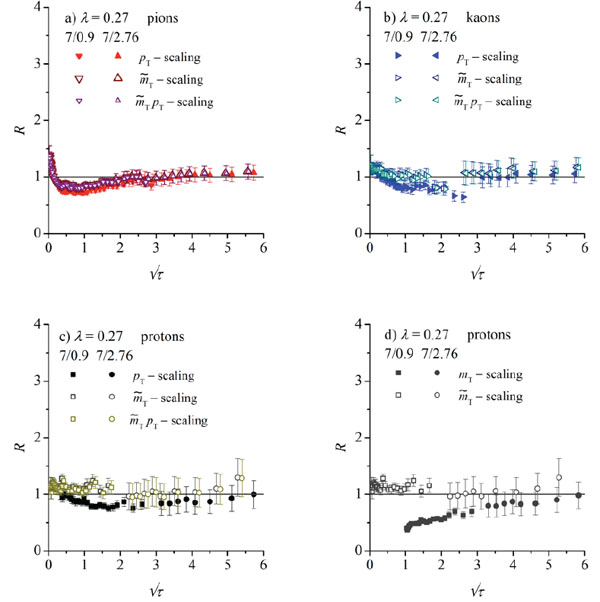 |
Fig.(5).
|
Finally in Fig. (5d), on the example of protons, we compare
11
for λ =0. 27. One can see that no GS has been achieved in the latter case. Qualitatively the same behavior can be observed for other values of λ.
7. CONCLUSIONS
In ref. [4] we have shown that GS in DIS works well up to rather large Bjorken x's with exponent λ = 0.32-0.34. In pp collisions at the LHC energies in central rapidity GS is seen in the charged particle multiplicity spectra, however, λ = 0.27 in this case [1]. By changing rapidity one can force one of the Bjorken x's of colliding patrons to exceed xmax and GS violation is expected. Such behavior is indeed observed in the NA61/SHINE pp data [5]. Finally we have shown that for identified particles scaling variable τ of Eq. (2) should be replaced by
CONFLICT OF INTEREST
The authors confirm that this article content has no conflicts of interest.
NOTES
1 For pp collisions we define ratios RWref,Wi as an inverse of (4).
ACKNOWLEDGEMENTS
Many thanks are due to the organizers of this successful series of conferences. This work was supported by the Polish NCN grant 2011/01/B/ST2/00492.








